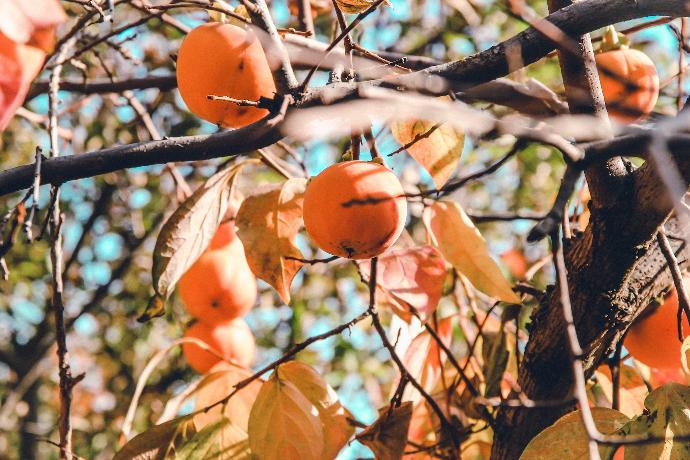Persimmon Plant
Persimmon trees, 15-25 feet tall and thriving in Zones 7-10, prefer well-drained soil and full sun for moderate growth. They produce edible persimmons and are valued for their medicinal properties.

Habit
Tree
Height
4 to 6 m
Growth
Moderate
Soil
Well-drained, Sandy Loam
Shade
Full Sun
Moisture
Moderate
Edible
Yes
Medicinal
Yes
Origin
East Asia, USA
Climatic Condition
Tropical, Subtropical
Temperature (°)
20°C to 30°C
Humidity (%)
60% to 80%
Potting media
50% Loam, 40% Sand, 10% Organic Matter
Fertilizers
Organic Fertilizer
Watering
Regular watering
Plant Weight
5 to 10 kg
Flowering Time
Fall to Winter
Soil Ph level
6.0 to 7.5
Water Ph level
6.0 to 7.0
Soil EC
0.5 to 1.0 mS/cm
Yield Per Plant
50 to 100 kg per tree
NPK ratio
3:02:01
life Span
20 to 30 years
Health Benefits
High in Vitamin C, Antioxidant
Suggested Grow Media or Potting Mix ?
60% loamy soil, 20% compost, 20% sand
Suggested Fertigation/Fertilizers
Fertilize every 6 weeks with a balanced, slow-release fertilizer.
Common Diseases and Remedies
Start writing here...
Anthracnose
brown spots, stunted growth
Crop rotation, neem cake as soil amendment
HEALTH BENEFITS
· Rich in vitamins A and C, boosting immunity and eye health.
· High in fiber, promoting digestion and gut health.
· Contains antioxidants that reduce inflammation and support heart health.
Helps regulate blood pressure and cholesterol levels.
What Is A Persimmon Tree?
Persimmons are deciduous trees that produce edible fruit. The fruits are mostly small berries with orange flesh and black seeds. The fruits are yellow, orange, or red. Persimmon is also known as Diospyrus virginiana.

What Are The Different Types of persimmon plants ?
1.Astringent persimmons:-
These persimmons cannot be eaten while still being hard, so they must ripen to a very soft state before they can be eatenA persimmon that can be eaten both hard and soft with the skin on.
2.Fuyu:-
A flat, stubby, crunchy, pale orange persimmon, when it's a little soft it's best to eat. It becomes sweeter when ripe, but can be eaten anytime. Fuyu persimmons can be sliced into salads or used like apples.
3.Hachiya:-
A bright orange and red persimmon shaped like an acorn, it is very soft and has a custard-like smooth texture. It is recommended to eat Hachiya persimmons after the pulp becomes soft.
4.Chocolate:-
Pollination variant, astringent persimmon. Since it has not been pollinated, the pulp is seedless, orange-yellow, and astringent. Chocolate is also a good pollinator to other varieties.

How do you care for persimmons?
1. Location:-
Persimmon trees grow in hot climates. It is resistant to heat and produces many fruits from summer to autumn.
2.Sunlight:-
Persimmon trees require at least 8 hours of sunlight per day to thrive. They will tolerate some shade.
3. Hydration:-
Water your persimmon tree once or twice a week for 10 minutes each time in the spring and summer. Persimmon seedlings don't need much water, but the soil must be kept moist.
4.Soil:-
Persimmon trees require well-drained, nutrient-rich soil.

5.Nutrition:-
Newly planted trees do not require fertilizer as their roots need to adapt to the nutrients in the soil.
6.Issues:-
Watering Pruning
What are the benefits of persimmon plants?
Persimmon leaves are also rich in vitamin C, tannins, and dietary fiber. These are common ingredients in therapeutic teas. Persimmons are rich in important vitamins and minerals such as potassium, manganese, and vitamins A, C, and B.

FAQ's About Growing Persimmon
1. Where do persimmon trees grow best?
persimmons grow best in full sun, hardiness zones 5 through 9, and lightly drained soil.
2. How to plant persimmons?
Potted persimmon trees can be planted year-round, but when planting, dig a hole twice as wide and as deep as the tree's root ball. Persimmons prefer deep, well-drained, slightly acidic soil.
3. How should I care for persimmons?
Persimmons are disease and pest free and generally tolerate drought once established. Aphids and other blood-sucking insects can be observed and can often be killed with insecticidal soap.
4. What are the tips for growing persimmons?
Please purchase in a pot or bag. Avoid trees with open or bare roots, as the roots may be susceptible to disease.
5. What are the best conditions for growing a persimmon tree?
Full sun. Like most fruit trees, persimmon trees need as much sunlight as possible.

